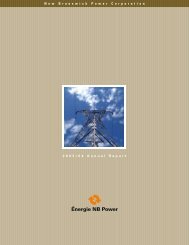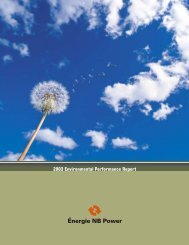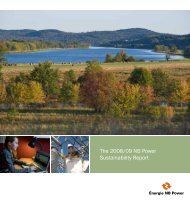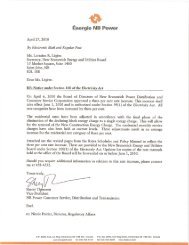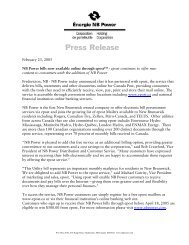Environmental Impact Assessment(EIA) Registration for the ...
Environmental Impact Assessment(EIA) Registration for the ...
Environmental Impact Assessment(EIA) Registration for the ...
Create successful ePaper yourself
Turn your PDF publications into a flip-book with our unique Google optimized e-Paper software.
REVISED PROJECT DESCRIPTION AND ENVIRONMENTAL IMPACT ASSESSMENT (<strong>EIA</strong>) REGISTRATION<br />
FOR THE NEPISIGUIT FALLS GENERATING STATION MODIFICATION AND REHABILITATION PROJECT<br />
metasedimentary and mafic volcanic of <strong>the</strong> Tetagouche Group that is intersected by a series of<br />
major and minor nor<strong>the</strong>ast trending faults (NBDNR 2007).<br />
The ecodistrict is characterized by its waterways including <strong>the</strong> Jacquet, Tetagouche and<br />
Nepisiguit Rivers. The Nepisiguit River is used <strong>for</strong> navigation and fishing, despite <strong>the</strong> presence<br />
of natural barriers (i.e., falls) along its length. These are often portaged by those navigating <strong>the</strong><br />
entire system.<br />
Forested area in <strong>the</strong> LAA consists of intermediate to mature intolerant hardwoods such as white<br />
birch (Betula papyrifera), trembling aspen (Populus tremuloides), and red maple (Acer rubrum);<br />
and softwood species such as red spruce (Picea rubens), black spruce (Picea mariana), balsam<br />
fir (Abies balsamea), and scattered eastern white pine (Pinus strobus). Wildlife in <strong>the</strong> area is<br />
not expected to be of an unusual abundance or diversity (NBDNR 2007). The LAA does not<br />
contain any important or specialized habitat, and is typical of nor<strong>the</strong>rn New Brunswick.<br />
3.5.1 Wildlife<br />
According to <strong>the</strong> AC CDC, <strong>the</strong>re have been nine wildlife species (8 birds and 1 mammal) of<br />
conservation concern have been previously observed within a 5 km radius of <strong>the</strong> PDA, of which<br />
three species are ranked S2 or higher (AC CDC 2010).<br />
One “regionally endangered” under NB ESA avian species, Bald Eagle (Haliaeetus<br />
leucocephalus), was recorded in <strong>the</strong> AC CDC database as being observed within a 5 km radius<br />
of <strong>the</strong> PDA. Bald Eagles nest in conspicuous stick nests, usually at or near <strong>the</strong> tops of large<br />
trees, such as white pines.<br />
Two “Threatened” under COSEWIC avian species, Chimney Swift (Chaetura pelagic) and<br />
Common Nighthawk (Chordeiles minor) were recorded in <strong>the</strong> AC CDC database results as<br />
being observed within a 5 km radius of <strong>the</strong> Project. The Chimney Swift typically nests in<br />
chimneys, though o<strong>the</strong>r structures such as hollow tree trunks can be used, and is associated<br />
with urban settings, though it also <strong>for</strong>ages and breeds over a variety of natural habitats including<br />
river-edge <strong>for</strong>est, <strong>the</strong> edge of tropical lowland evergreen <strong>for</strong>est and second-growth scrub. The<br />
Common Nighthawk traditionally nests on <strong>the</strong> ground in open areas such as burns and<br />
clearcuts.<br />
The AC CDC report recorded possible occurrences of two o<strong>the</strong>r rare or uncommon avian<br />
species within a 5 km area of <strong>the</strong> Project, although no specific observations have been made.<br />
The Harlequin Duck (Histrionicus histrionicus) is commonly found along rocky coasts and nests<br />
inland up streams and rivers. The Red-shouldered Hawk (Buteo lineatus) can be found in<br />
<strong>for</strong>ests with open understory, especially bottomland hardwoods, riparian areas, and flooded<br />
swamps.<br />
Page 28 June 15, 2011




